Why diverse local stories should be told and celebrated
Preston Guild is the only one of its kind flourishing today. Making in the North and Preston Guilds through the decades have shaped the creative lives of the region and beyond. This lasting heritage provides the bedrock for new inspiring stories.

PRESTON GUILD 2032
There are many hidden tales to tell, contemporary stories that can be created and shared in diverse ways in the run-up to the next Preston Guild in 2032.
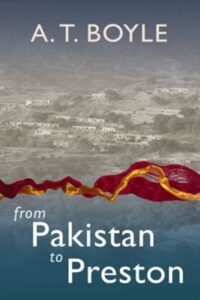
Based on Courtaulds artificial silk laboratory in Preston, this love story is set at the time of Preston Guild 1972.
Woven through the book is wordplay naming the hundreds of textile shades produced, the languages spoken in that factory including Urdu and Italian, and the diverse international friendships made for life – all shaping the North’s cultural landscape of today.
The first edition of from Pakistan to Preston, launched at Preston Guild 2012 with the local Mayor, sold out with months of publication. The stories continue.
The author credit ‘A.T. Boyle’ is a combination of the first names Alison and Terry. If you are interested in telling and reading imaginative stories of Preston then and now, get in touch: artificialsilkorg@ gmail.com
A LIFE MEASURED IN GUILDS
Many people remark that, because Preston Guild is such an important local event, they measure their lives in Guilds. Four Guilds – 80 years – is said to be a very good innings. It’s a longer-lived equivalent to the saying ‘three score years and ten’ which is 70 years.
Usually occurring every twenty years, there was a blip in 1942 when the Second World War caused a 10-year delay. That Guild was eventually staged in 1952, the year Jean Crossthwaite and Terry Boyle met. See the personal Guild timeline story below…
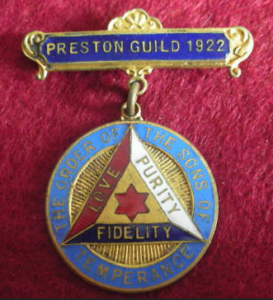
CELEBRATING DIVERSE COMMUNITIES
In the 20 years between one Preston Guild and the next, it’s important to celebrate the unique experiences and perspectives of the people who came to England to work in Preston, including in our textile industries.
Workers in Preston’s artificial silk manufacture came from countries including Belgium, India, Lithuania, Pakistan, Poland, the Ukraine and the West Indies. Many Italian prisoners of war settled in Preston.
The Fons character in the novel from Pakistan to Preston is a second generation Italian. Moor Park in Preston housed Italian prisoners of War. Characters in the fictional story set in a Guild year of the past reflect these and already resident communities. Roman Urdu (phonetics) and Lancashire dialect feature in the book.
New stories are being written about Preston and Lancashire. See the first book of exObjects launched in India at the end of 2024, with eight stories by A.T. Boyle about Preston and Blackpool and Indian novelists, scriptwriters and historians.

A PERSONAL GUILD HERITAGE TIMELINE
1952 Guild Jean Crossthwaite and Terry Boyle (Alison Boyle’s parents) went to one of many Guild week dances together. Having met in the lab of Courtaulds artificial silk factory at Red Scar, two years later they were married. They gave names to many of the shade names for the textiles.
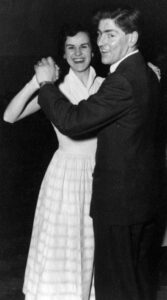
1972 Guild The procession, street parties and more feature in the novel from Pakistan to Preston story co-written by Alison and Terry Boyle, with Urdu translations. Avenham Park just after Concorde made a noisy and memorable flyover has a place in the story too.
A.T. Boyle took part in a mass participation event as a schoolgirl. In 1972 this included every school in Preston. On the grass by the River Ribble the pupils made up hundreds of cogs powering a factory machine, moving in synch.
2012 Guild LightNight on 31st August at the old Museum of Lancashire in Preston launched a love story about a woman from Pakistan and a man from Preston. These two young people met at a textile factory and lived in Acregate. Launched by the Guild mayor Carl Compton, the event including a book reading and party fare.
Refreshments were burfi (fudge) from the sweet shop round the corner in Acregate Lane where Terry Boyle used to live – the setting for the novel – and huge ‘squashed ant’ Eccles cakes (pastry and sugared raisins).
Next gen Guild 2012
Author A.T. Boyle returned to her old school in Preston (the formerly named Lark Hill Sixth Form, now Cardinal Newman College). The students produced some inspiring creative writing and asked probing questions.

Media students at Penwortham Girls High School filmed the book author’s visit in 2012 as a way of welcoming their new intake of students.
After their writing workshop in 2012, pupils at Fulwood Academy asked a few new questions as well as old chestnuts like, How money do you make? and How famous are you?
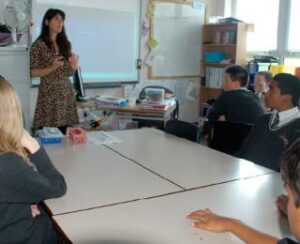
Outdoor events Guild 2012 Performances in Avenham Park on 3rd September by local poets included a reading by A.T. Boyle from the novel from Pakistan to Preston as people lounged on deckchairs in the Preston sunshine.
BBC Radio Lancashire Guild 2012 Gilly (John Gilmore, BBC Radio Lancashire) broadcast live for three hours from Walton-le-Dale primary school on 12th September. Pupils took part in a writing and creative drawing workshop with A.T. Boyle.
Gilly interviewed the author, teachers and pupils about how they had been inspired by the Guild, the regional Cultural Olympiad celebrations and the from Pakistan to Preston love story set in a local factory. The 2012 Walton-le-Dale classes made painted tiles with shields of the Green Guild, the Merchants’ Guild and the People’s Guild.

“We all had a fantastic day and to be honest the week and a half has been one of the best whole school projects we’ve done. It’s so inspiring for the children (and us as a staff) to have had the opportunity to work with you. As I mentioned yesterday it’s given me plenty of ideas for continuing themes!”
Jen Douglas, Curriculum Leader, Walton-le-Dale primary school
Readers and Writers Day at Macclesfield Library in Cheshire on 22nd September 2012 featuring the love story about Preston written by Terry and Alison Boyle. The library manager give a customised cupcake topped with a tiny icing sugar book to each participating author. (No photograph available. Cupcake consumed.)
The Harris Library Preston hosted a father and daughter book reading and talk on 24th November 2012 about artificial silk and the Preston love story.

The T in A.T. Boyle guided the library audience through some of the complex processes of making artificial silk from wood pulp and pigmenting the filaments with shades whose vibrancy lasts to this day. Read more about the making of Preston’s artificial silk (viscose/rayon) here
Terry advised the audience not to spread viscose on hot buttered toast, or in fact anything you plan to eat because the chemical would harm you.
2014-2015
Launch of a four-month exhibition curated by A.T. Boyle and Artificial Silk about Preston’s textile making was launched at the People’s History Museum on the Salford-Manchester border.
The interactive events, some programmed with Manchester Science Festival, attracted over 22,000 visitors from the region, nationally and internationally.
Obituaries of Terry and Jean Boyle published in The Guardian in 2021 and the launch of exObjects in 2022:

1920s-1960s Alice Crossthwaite and Annie Boyle (grandmothers to Alison Boyle) work as weavers in Preston’s cotton mills.
1939 the gates of Courtaulds, an artificial silk factory, opens in Preston, Lancashire, on the eve of the Second World War. Employing 3,500 workers, those same gates closed 41 years later.
1947 Jean Crossthwaite and Terry Boyle start working as teenagers in the colour laboratory of Courtaulds Red Scar.
1952 Jean and Terry go to one of many Guild week dances together.
1954 Jean and Terry are married.
1956 Jean leaves her job in the laboratory because she is pregnant with her first child – there was no choice for women at that time.
1950 – 1980 stories about textile shades and shade names emerge… factory spillages of bright red pigment, a fire, the humour and resilience of thousands of factory workers on a single Lancashire manufacturing site.
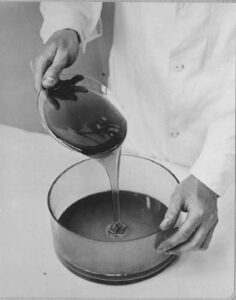
1972 Guild features in the from Pakistan to Preston story with Urdu translations. Avenham Park just after Concorde makes a noisy and memorable flyover has a place in the story too.
1980 the gates of Courtaulds are shut, with the loss of 2,600 jobs a time of mass unemployment.
31st August 2012 Launch of the novel from Pakistan to Preston at the old Lancashire Museum. A promotional film created by young Northern creatives Jemima Louise Pollitt and Nathan Staddon draws on interview material from artificial silk workers. It is shown at the event.
3rd September 2012 Miller Park is host to Preston born animator Nick Park, creator of Wallace and Gromit, and a rang group from Blackburn displaying colourful seed patterns on Top Walk in Avenham Park where Victorian families and couples promenaded every Sunday.
In the book story from Pakistan to Preston Tommy makes a new shade for the Guild Mayor in 1972. Forty years later, at Preston Guild 2012, the character anticipates a school visit where he will talk to children about the North’s heritage. Terry gave talks in Preston during 2012 and at The World Museum in Liverpool.
24th May 2013 The World Museum Liverpool foyer is decorated with fabrics from around the world for Lifelong Learning week. A talk by co-authors Alison and Terry Boyle about how artificial silk was made from the wood pulp in fir trees (transported from Norway to Preston then on to the factory by a branch line) is aided by an artificial Christmas tree – an incongruous object on a sunny bank holiday weekend in Liverpool.

Preston Mela June 2013 has South Asian classical and Bollywood dance performances at the Flag Market and three princesses on stilts at Preston’s Fish Market.
Manchester Mela July 2013 on Platt Fields Park brings visitors to an Artificial Silk paranda stall in the Arts and Crafts tent. Participants chose their favourite colours of silk thread and made tassels to attach to their hair. Some things we overhear:

“These shades look brilliant together.” (mother)
“My aunty’s paranda is really old.
She washes it every few days. It gets a bit knotted.” (teenager)
“Let me show you.” (female elder)
“Thank you. Can we take it home?” (10 year-old boy)
10th September 2014 The Blackburn with Darwen trailblazer sees a group of library visitors exploring the shade names of artificial silk produced in Lancashire in a workshop with Artificial Silk.
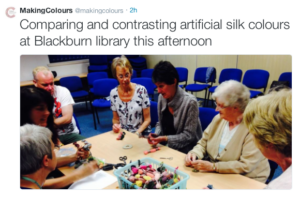
A pair of trousers being worn by one of the participants that had been labelled ‘nougat’ by a shop assistant leads us to look more closely at the labels sewn into our garments that day. Here’s a small sample of the shade wordplay produced:
clover pink, moss green, sage
olive green, russet, wheat
baby pink, pale coffee, charcoal
dusty turquoise, dusty pink, teal
silver grey, burgundy, buttercup
coral pink, mink brown and heather
Craft objects made by the participants in Blackburn anre attached to the Big-Up Female Boffins banner in the Colours, Community and Chemistry exhibition. This 17-week collaboration with regional artists, Leeds archivists and Manchester scientists celebrating Preston manufacturing attracted over 22,000 visitors to the People’s History Museum. Find out more.
GUILD BEGINNINGS TO NOW IN A NUTSHELL
In 1179, King Henry II granted Preston the right to have a Guild Merchant. The Guild was an organisation of traders, craftsmen and merchants that controlled trade in the Lancashire town.
Every twenty years the Guild met to update its records, admit new members, and deal with people falsely claiming the right to trade. Gatherings were a good excuse to hold processions. After the Guild lost its power in 1790, the Guild Merchant survived because the celebrations had grown into prestigious social occasions.
Unless it is interrupted, we can look forward to more amazing conversations and making at the next Preston Guild in 2032.